By Angie Peltier and Jared Goplen
UMN Extension soybean IPM scouts traveled across northwest and west central Minnesota completing another week of data collection on July 16. When visiting each soybean field, scouts first sweep for grasshoppers in the grassy area next to the field and then begin walking in a zig-zag pattern throughout the field, stopping along the way to growth stage the crop and examine 31 plants for soybean aphids, aphids that have been colonized by parasitic wasps, bean leaf beetles and spider mites.
Growth stages.
For the most part, soybeans in northwest counties were either just beginning to bloom or had reached full bloom (Figure 1). Further south, soybeans had all reached full bloom with some crops reaching the full pod growth stage.
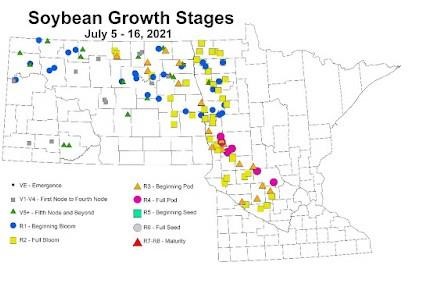
Figure 1. Growth stages of soybeans scouted between July 5 and 16 as part of the UMN Extension 2021 soybean IPM survey. Map source: NDSU IPM program.
Grasshoppers.
Scouts used a sweep net to capture and count grasshoppers in the grassy area adjacent to each scouted soybean field. There were only a handful of field margins in which adult grasshoppers were not found (Figure 2). At the rest of the locations, at least one and up to five grasshoppers were captured, with up to 10 grasshoppers at some locations and up to 20 at only a handful of locations. As grasshoppers consume their current food sources or their preferred food source (think small grains) matures, they may be looking for a living crop to feed on. UMN Extension has resources to help you to determine whether crop injury and grasshopper densities indicate that treatment is warranted.
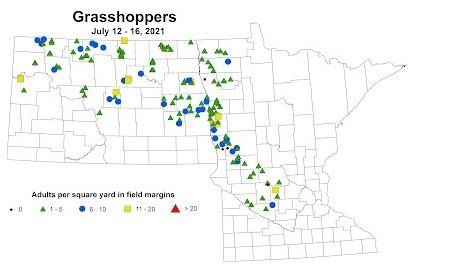
Figure 2. Density of adult grasshopper populations along margins of fields scouted between July 5 and 16 as part of the 2021 UMN Extension soybean IPM survey. Map source: NDSU IPM program.
Soybean aphids
If you’ll recall, one milestone that must be met to reach the soybean aphid treatment threshold is for at least 80% of soybeans to be infested. Although one field in Pope County had 38% of plants infested, for the most part last week’s soybean aphid incidence, or the percentage of the scouted plants, remained relatively low (Figure 3). In last week’s scouting summary, we highlighted the effect of temperature on growth and development of these cold-blooded animals. The recent hot temperatures throughout the region likely contributed to low aphid incidence, but 38% incidence is the highest we have seen in this survey to date and so continued vigilance is called for.
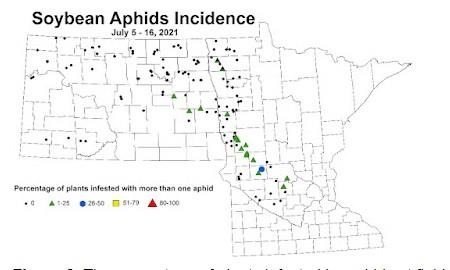
Figure 3. The percentage of plants infested by aphids at field locations scouted between July 5 and 16 as part of the 2021 UMN Extension soybean IPM survey. Map source: NDSU IPM program.
Another of the conditions that must be met in order for the soybean aphid treatment threshold to be met is that there be an average of 250 aphids per plant. In the fields visited for this survey, an average of fewer than 21 aphids per plant were observed (Figure 4). Because under conditions favorable for aphid reproduction a new generation of pregnant females can be born every 7 to 10 days and populations can double in as fast as 2 to 3 days, continued scouting is recommended.
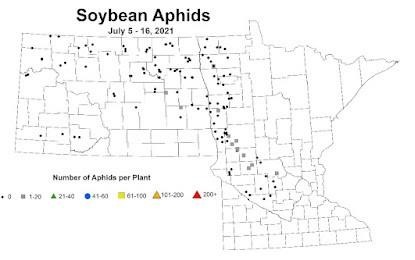
Figure 4. The average number of soybean aphids per plant in fields scouted between July 5 and 16 as part of the UMN Extension 2021 soybean IPM survey. Map source: NDSU IPM program.
Spider mites.
When one thinks of crop pests that thrive in hot, dry and droughty weather, two-spotted spider mites (TSSM) immediately come to mind. While last week’s IPM survey scouting efforts in both western Minnesota and North Dakota found only one location with an edge-of-field TSSM infestation (Figure 5), the continued hot temperatures and a dearth of rain in parts of Minnesota indicate that scouting for TSSM scouting continue. UMN Extension IPM specialist Bruce Potter has begun to find TSSM populations in southcentral and southeast Minnesota and reports that at it is difficult to find a plant without TSSM at the Southwest Research and Outreach Center in Lamberton.
With a persistent drought throughout parts of Minnesota, keep your eyes peeled for the distinctive stippling injury and webbing caused by spider mites and consult information compiled by UMN Extension regarding spider mite scouting, treatment thresholds and miticide options (Potter et al., 2020).
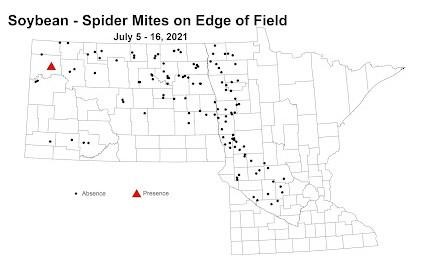
Figure 5. Presence or absence of spider mites on the edge of fields scouted between July 5 and 16 as part of the UMN Extension 2021 soybean IPM survey. Map source: NDSU IPM program.
Please note that while this scouting program can identify regions in which soybean aphid population densities are growing, it is no substitute for diligently scouting your own fields. Fields scouted in this program were selected randomly without prior knowledge regarding seed- or post-applied insecticides, which can affect early-season aphid colonization.
Thanks to Minnesota Soybean Research & Promotion Council for funding this survey.
Source : umn.edu